12.9 The Romantic Spirit
How would you define romance? How is romance related to love, a hope for the future, and a longing to hold on to the past? What characterizes your definition of romance?
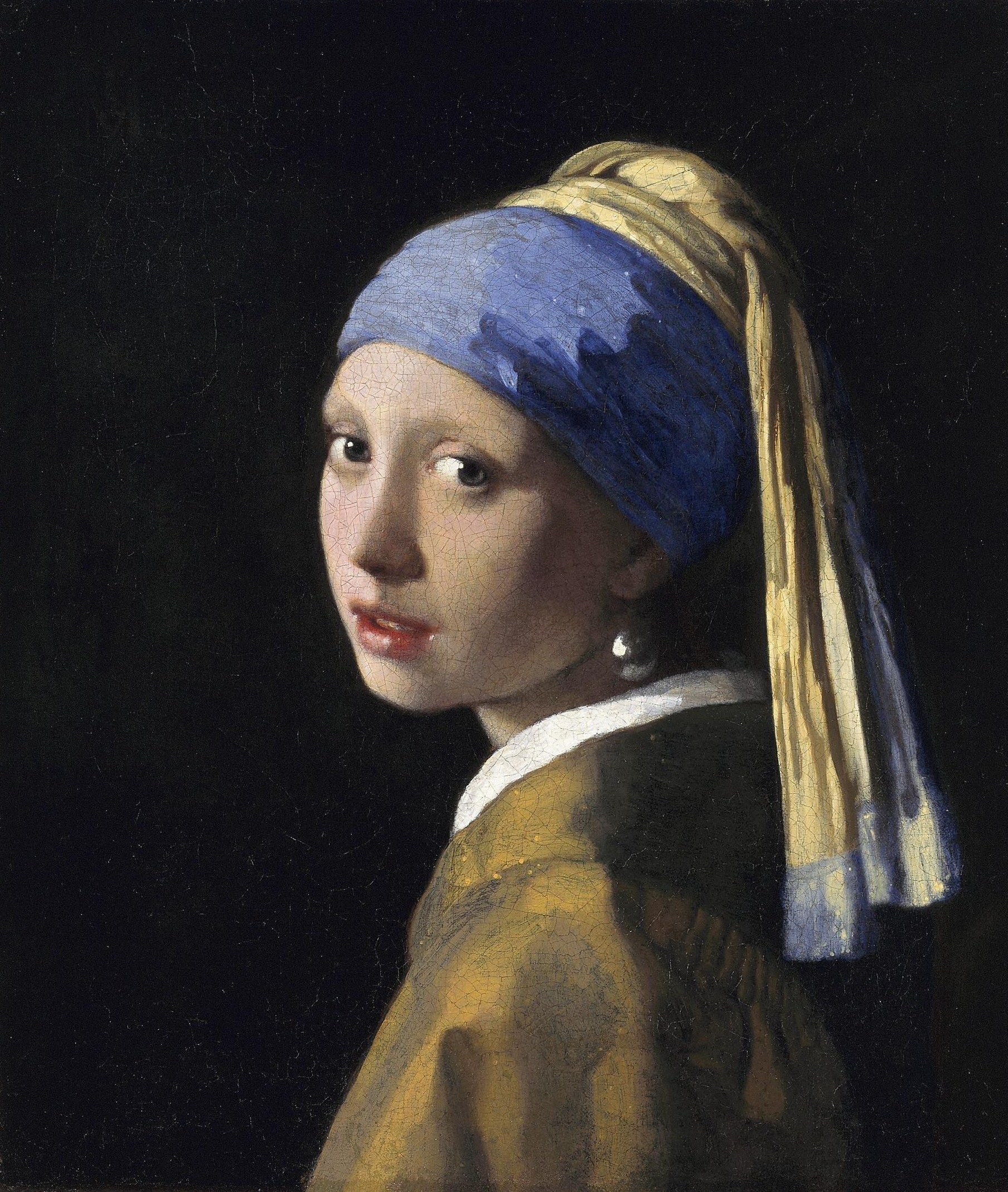
Courtesy: By Johannes Vermeer – Geheugen van Nederland : Home : Info : Pic, Public Domain, https://commons.wikimedia.org/w/index.php?curid=4408646
Maurishuis Art Museum Note
“Girl with a Pearl Earring is Vermeer’s most famous painting. It is not a portrait, but a ‘tronie’ – a painting of an imaginary figure. Tronies depict a certain type or character; in this case a girl in exotic dress, wearing an oriental turban and an improbably large pearl in her ear.Johannes Vermeer was the master of light. This is shown here in the softness of the girl’s face and the glimmers of light on her moist lips. And of course, the shining pearl.”(Retrieved June 10, 2023 Maurishuis Museum Webpage.
Girl with Pearl Earring by Johannes Vermeer (Excerpt) by W. S. Di Piero
He put the spirit essence
the light pip not only
in each eye’s albumen
concentrate of starlight
but must have been taught
how to do that by first
finding it in the pearl….
(For the complete poem please open The Poetry Foundation link here.
“Girl with Pearl Earring by Johannes Vermeer” Excerpt from Skirts And Slacks: Poems, 2021 Alfred A. Knopf, a division of Random House, Inc. Retrieved All Poetry Foundation.
The Imaginative Realm of Poetry by W.S. Piero
“The imaginative dimension a poem creates in language is like space in a painting, a one-time event, a unique locale in which poetry (or image-making activity) can happen. Poetry’s space is composed and energized by formal dynamics. I’m not talking about rhyme and meter. Form is a poem’s internal economy, the pattern composed of musicality, rhythm, and sense, created by whatever means. If, as the maxim goes, poetry teaches me how to live, it does so in its mysterious effects of completed form. If it teaches, it does so by shooting its formal force straight into the bloodstream of my consciousness, and it lives its life in me more as instinct than as moral awareness. So it’s not what’s said in poems that has been exemplary to me, it’s poetry’s charged, whole, instantaneous pattern of form that is simultaneously a pattern of feeling.” ( W.S Piero, 2009, City Dog: Essays by W.S. Piero, Afred A. Knopf from The Poetry Foundation website )
To learn more about W.S. Piero, please open the link here.

Courtesy: By Alexander Roslin – Nationalmuseum, Public Domain, https://commons.wikimedia.org/w/index.php?curid=52120654
Nationalmuseum, Stockholm, Sweden.
Note on the Painting:
“The veiled beauty in Alexander Roslin’s portrait is his wife, Marie Suzanne Giroust, who was herself a prominent artist. She is dressed for a fancy-dress ball, in the Bolognese style. The attraction of this image builds very much on a play of opposites, such as intimate–inaccessible and seductive–reserved. The Lady with the Veil is one of the Nationalmuseum’s best-known paintings. It was exhibited in Paris in 1769, along with another portrait by Roslin, of a woman in African costume.” (Retrieved May 12, 2023.
For more information about the artist Marie-Suzanne Giroust please open the link here and to learn more about Alexander Rosin, please open the link here.
“Delight in Disorder” by Robert Herrick
A sweet disorder in the dress
Kindles in clothes a wantonness;
A lawn about the shoulders thrown
Into a fine distraction;
An erring lace, which here and there
Enthrals the crimson stomacher;
A cuff neglectful, and thereby
Ribands to flow confusedly;
A winning wave, deserving note,
In the tempestuous petticoat;
A careless shoe-string, in whose tie
I see a wild civility:
Do more bewitch me, than when art
Is too precise in every part.
“The metaphysical poets were a group of 17th-century poets whose works are marked by philosophical exploration, colloquial diction, ingenious conceits, irony, and metrically flexible lines. Topics of interest often included love, religion, and morality, which the metaphysical poets considered through unusual comparisons, frequently employing unexpected similes and metaphors in displays of wit.” (Poetry Foundation).
Well-known metaphysical poets were John Donne, Andrew Marvell, Henry Vaughan, and Robert Herrick. To learn more about Metaphysical poetry please open the link here and here.
To learn more about the metaphysical poet Robert Herrick (1591-1674) please open the link here and to read more poetry by Robert Herrick please open the Project Gutenberg here
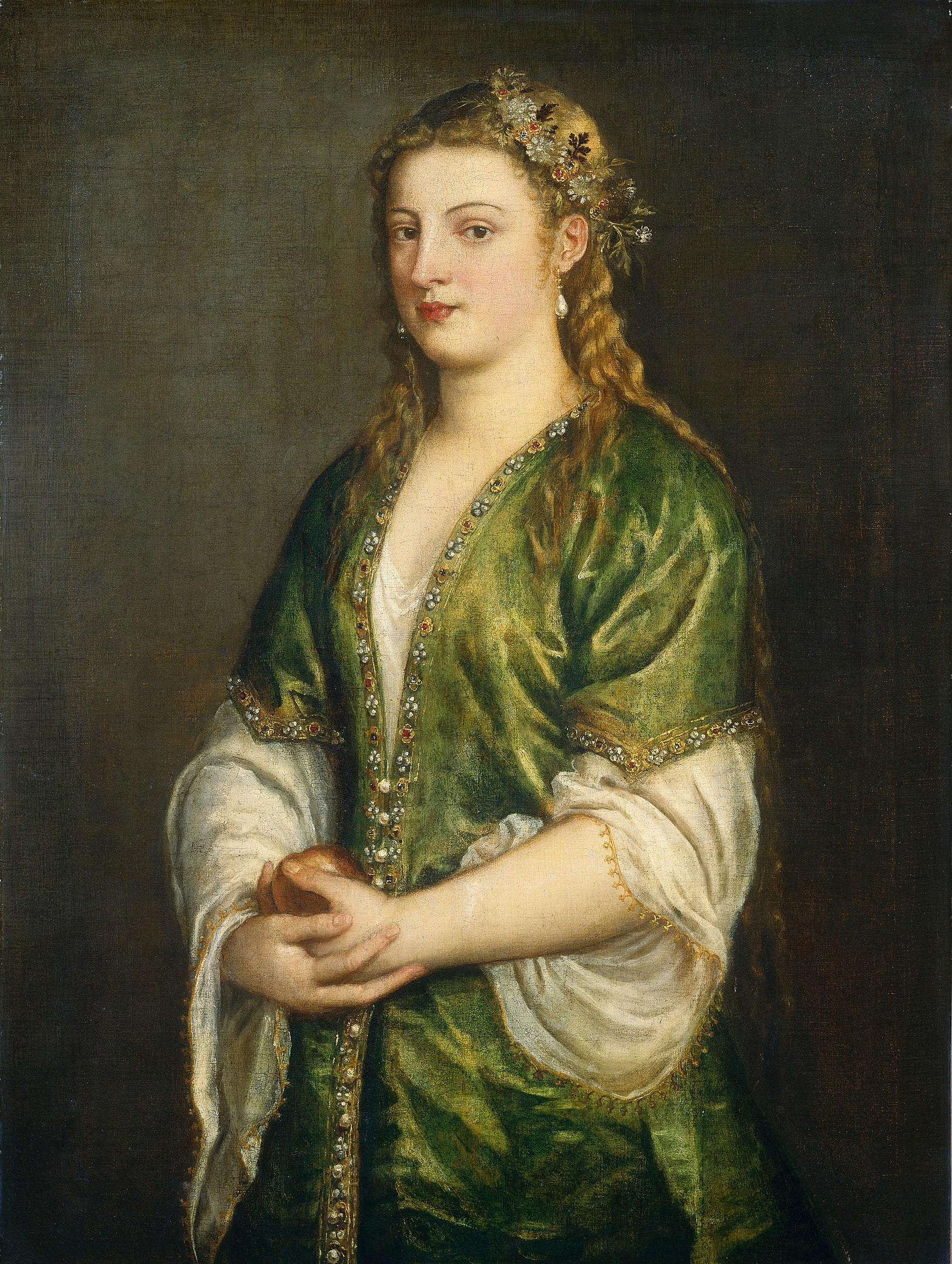
Courtesy: By Titian – [1], Public Domain, https://commons.wikimedia.org/w/index.php?curid=7914762
“Upon Julia’s Clothes” by Robert Herrick (1591–1674)
Whenas in silks my Julia goes,
Then, then (methinks) how sweetly flows
That liquefaction of her clothes.
Next, when I cast mine eyes, and see
That brave vibration each way free,
O how that glittering taketh me!
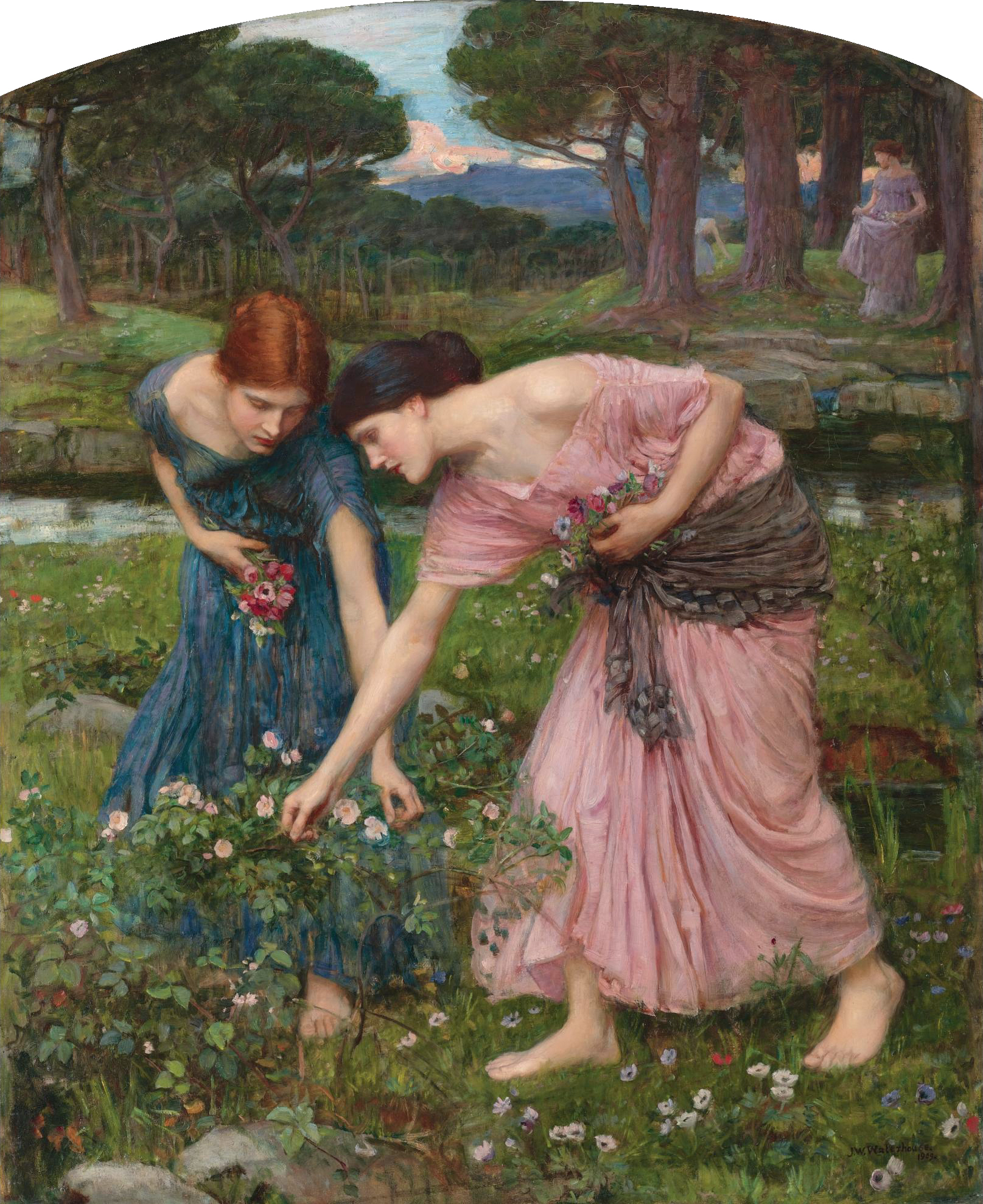
Courtesy: By John William Waterhouse – Sotheby’s – image, Public Domain, https://commons.wikimedia.org/w/index.php?curid=184819
“To the Virgins, to Make Much of Time” by Robert Herrick (1591-1674)
Gather ye rosebuds while ye may,
Old Time is still a-flying;
And this same flower that smiles today
Tomorrow will be dying.
The glorious lamp of heaven, the sun,
The higher he’s a-getting,
The sooner will his race be run,
And nearer he’s to setting.
That age is best which is the first,
When youth and blood are warmer;
But being spent, the worse, and worst
Times still succeed the former.
Then be not coy, but use your time,
And while ye may, go marry;
For having lost but once your prime,
You may forever tarry.
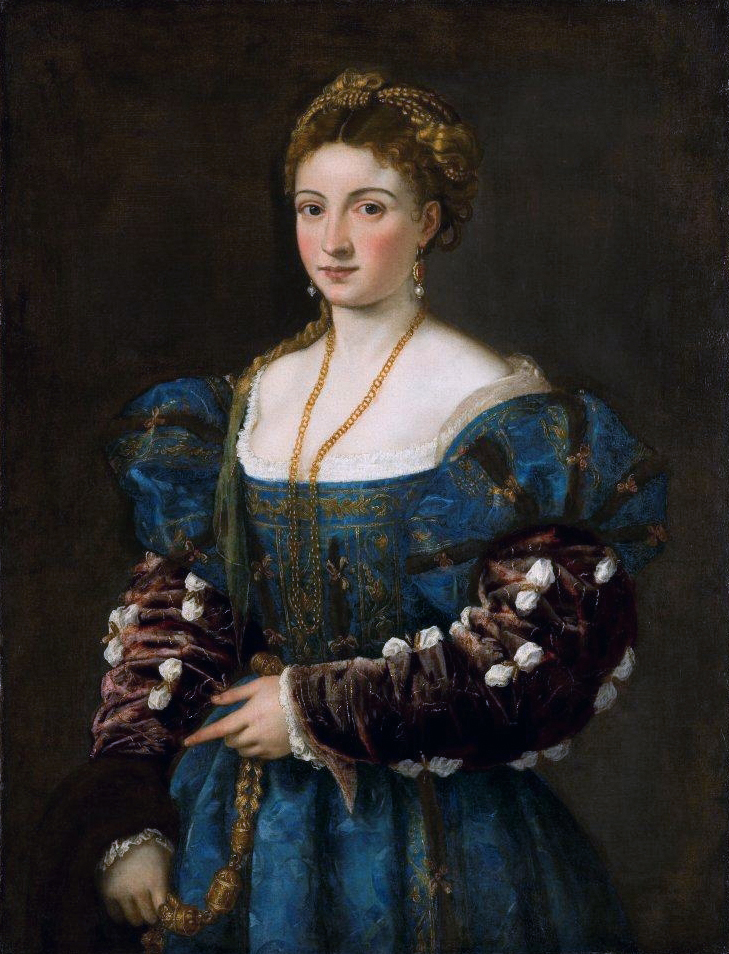
Courtesy: By Titian – The Yorck Project (2002) 10.000 Meisterwerke der Malerei (DVD-ROM), distributed by DIRECTMEDIA Publishing GmbH. ISBN: 3936122202., Public Domain, https://commons.wikimedia.org/w/index.php?curid=159509
“My Last Duchess” by Robert Browning
Ferrara
That’s my last Duchess painted on the wall,
Looking as if she were alive. I call
That piece a wonder, now; Fra Pandolf’s hands
Worked busily a day, and there she stands.
Will’t please you sit and look at her? I said
“Fra Pandolf” by design, for never read
Strangers like you that pictured countenance,
The depth and passion of its earnest glance,
But to myself they turned (since none puts by
The curtain I have drawn for you, but I)
And seemed as they would ask me, if they durst,
How such a glance came there; so, not the first
Are you to turn and ask thus. Sir, ’twas not
Her husband’s presence only, called that spot
Of joy into the Duchess’ cheek; perhaps
Fra Pandolf chanced to say, “Her mantle laps
Over my lady’s wrist too much,” or “Paint
Must never hope to reproduce the faint
Half-flush that dies along her throat.” Such stuff
Was courtesy, she thought, and cause enough
For calling up that spot of joy. She had
A heart—how shall I say?— too soon made glad,
Too easily impressed; she liked whate’er
She looked on, and her looks went everywhere.
Sir, ’twas all one! My favour at her breast,
The dropping of the daylight in the West,
The bough of cherries some officious fool
Broke in the orchard for her, the white mule
She rode with round the terrace—all and each
Would draw from her alike the approving speech,
Or blush, at least. She thanked men—good! but thanked
Somehow—I know not how—as if she ranked
My gift of a nine-hundred-years-old name
With anybody’s gift. Who’d stoop to blame
This sort of trifling? Even had you skill
In speech—which I have not—to make your will
Quite clear to such an one, and say, “Just this
Or that in you disgusts me; here you miss,
Or there exceed the mark”—and if she let
Her wits to yours, forsooth, and made excuse—
E’en then would be some stooping; and I choose
Never to stoop. Oh, sir, she smiled, no doubt,
Whene’er I passed her; but who passed without
Much the same smile? This grew; I gave commands;
Then all smiles stopped together. There she stands
As if alive. Will’t please you rise? We’ll meet
The company below, then. I repeat,
The Count your master’s known munificence
Is ample warrant that no just pretense
Of mine for dowry will be disallowed;
Though his fair daughter’s self, as I avowed
At starting, is my object. Nay, we’ll go
Together down, sir. Notice Neptune, though,
Taming a sea-horse, thought a rarity,
Which Claus of Innsbruck cast in bronze for me!
For more examples of the dramatic romances by Robert Browning please open the Project Gutenberg link below.
Dramatic Romances, by Robert Browning (gutenberg.org) https://www.gutenberg.org/cache/epub/4253/pg4253-images.html
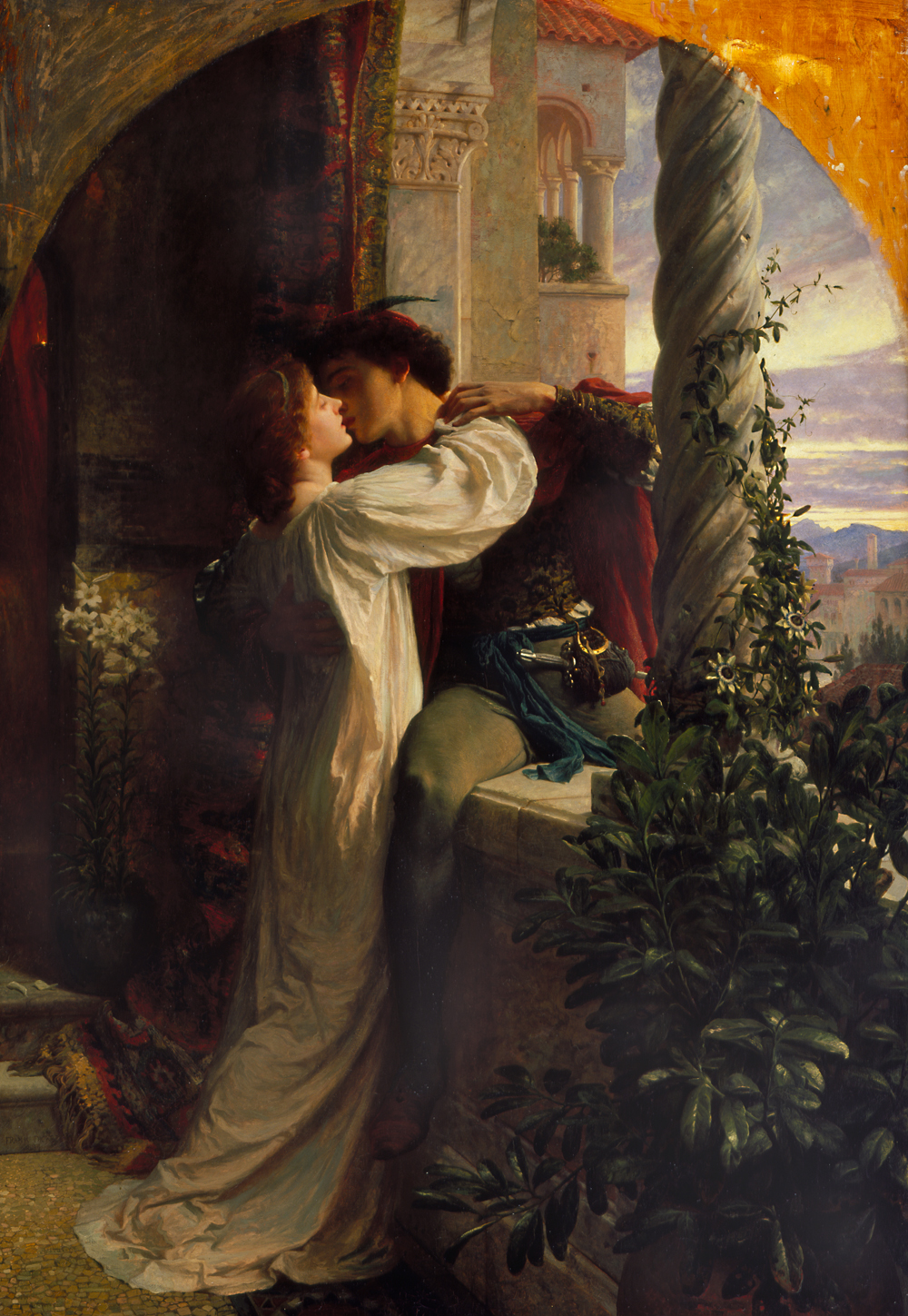
Courtesy: By Frank Bernard Dicksee – http://www.odysseetheater.com/romeojulia/romeojulia.htm, Public Domain, https://commons.wikimedia.org/w/index.php?curid=896519
“Sonnet 18” by William Shakespeare
Shall I compare thee to a summer’s day?
Thou art more lovely and more temperate.
Rough winds do shake the darling buds of May,
And summer’s lease hath all too short a date.
Sometime too hot the eye of heaven shines,
And often is his gold complexion dimmed;
And every fair from fair sometime declines,
By chance, or nature’s changing course, untrimmed;
But thy eternal summer shall not fade,
Nor lose possession of that fair thou ow’st,
Nor shall death brag thou wand’rest in his shade,
When in eternal lines to Time thou grow’st.
So long as men can breathe, or eyes can see,
So long lives this, and this gives life to thee.
“Love’s Philosophy” by Percy Bysshe Shelley (1792-1822)
The fountains mingle with the river
And the rivers with the ocean,
The winds of heaven mix for ever
With a sweet emotion;
Nothing in the world is single,
All things by a law divine
In one another’s being mingle—
Why not I with thine?
See the mountains kiss high heaven,
And the waves clasp one another;
No sister-flower would be forgiven
If it disdain’d its brother;
And the sunlight clasps the earth,
And the moonbeams kiss the sea—
What is all this sweet work worth
If thou kiss not me.
For the complete poetical works of John Keats, please open the Project Gutenberg ebook link below.
https://www.gutenberg.org/ebooks/author/935
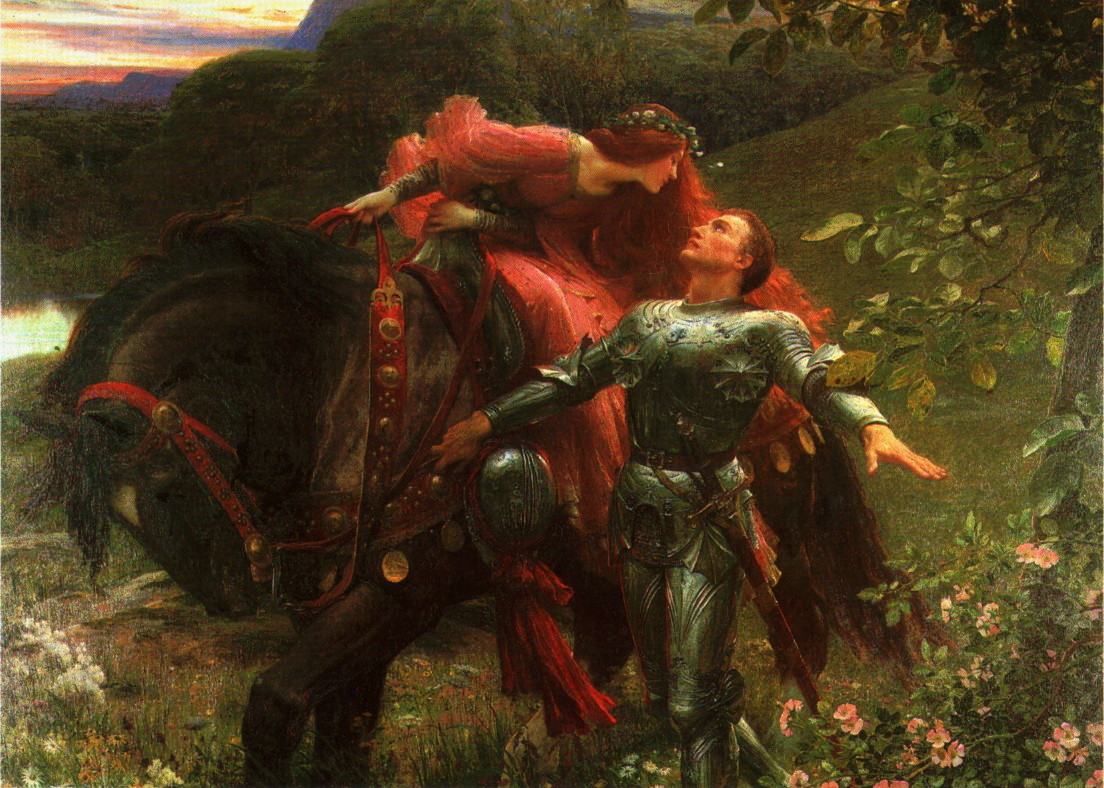
Dicksee’s (1901) painting brings to life the ballad by John Keats. Think of a person in your life who has brought you great happiness and sadness. Compare this classic poem with Lord Randall. What similarties can you find? Can you find a comparable picture to illustrate “Lord Randall.” Research the history of the painting and the poem. To what extent are the poems rooted in fact?
“La Belle Dame sans Merci: A Ballad” by John Keats
O what can ail thee, knight-at-arms,
Alone and palely loitering?
The sedge has withered from the lake,
And no birds sing.
O what can ail thee, knight-at-arms,
So haggard and so woe-begone?
The squirrel’s granary is full,
And the harvest’s done.
I see a lily on thy brow,
With anguish moist and fever-dew,
And on thy cheeks a fading rose
Fast withereth too.
I met a lady in the meads,
Full beautiful—a faery’s child,
Her hair was long, her foot was light,
And her eyes were wild.
I made a garland for her head,
And bracelets too, and fragrant zone;
She looked at me as she did love,
And made sweet moan
I set her on my pacing steed,
And nothing else saw all day long,
For sidelong would she bend, and sing
A faery’s song.
She found me roots of relish sweet,
And honey wild, and manna-dew,
And sure in language strange she said—
‘I love thee true’.
She took me to her Elfin grot,
And there she wept and sighed full sore,
And there I shut her wild wild eyes
With kisses four.
And there she lullèd me asleep,
And there I dreamed—Ah! woe betide!—
The latest dream I ever dreamt
On the cold hill side.
I saw pale kings and princes too,
Pale warriors, death-pale were they all;
They cried—‘La Belle Dame sans Merci
Thee hath in thrall!’
I saw their starved lips in the gloam,
With horrid warning gapèd wide,
And I awoke and found me here,
On the cold hill’s side.
And this is why I sojourn here,
Alone and palely loitering,
Though the sedge is withered from the lake,
And no birds sing.
“A Thing of Beauty Is a Joy Forever (From Endymion)” by John Keats
(Retrieved June 12, 2023
Excerpt from A Day with Keats by May Byron (1861-1936)
“[Keats] is seeing visions all the while. Some chance sight or sound has wrapt him away from the young greenness of the May morning, and plunged him deep into the opulent colour of September. His prophetic eye sees all the apple-buds as golden orbs of fruit, and the swallows, that now build beneath the eaves, making ready for their departure. And these future splendours shape themselves into lines as richly coloured…”
A Day with Keats by May Byron. Please open the link here.
To read the mythical story of Endymion, please open the link here.
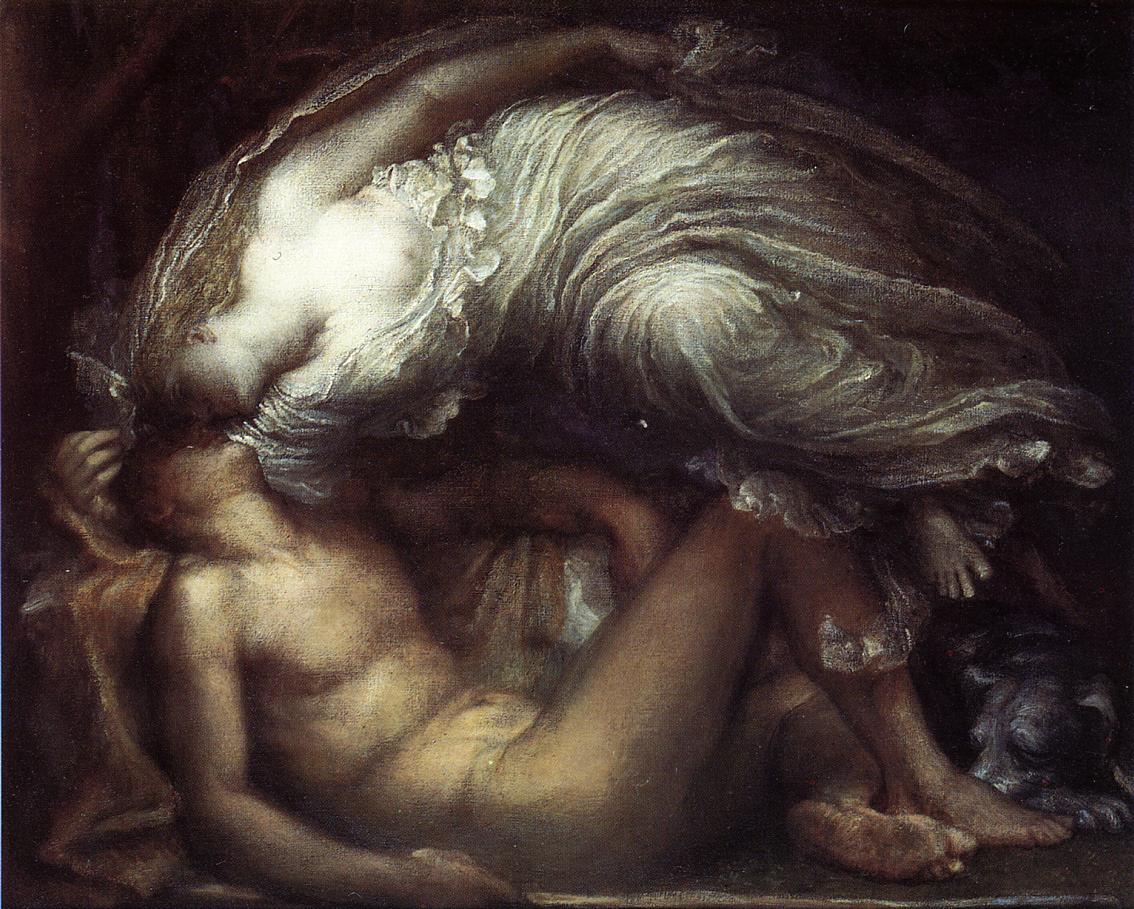
Courtesy: By George Frederic Watts – George Frederic Watts, 1872, Public Domain, https://commons.wikimedia.org/w/index.php?curid=28042753

Courtesy: By Giovanni Antonio Pellegrini – Art UK, Public Domain, https://commons.wikimedia.org/w/index.php?curid=91971802
Lord Randall by Anonymous (17th Century Ballad, English)
“Oh where ha’e ye been, Lord Randall my son?
O where ha’e ye been, my handsome young man?”
“I ha’e been to the wild wood: mother, make my bed soon,
For I’m weary wi’ hunting, and fain wald lie down.”
“Where gat ye your dinner, Lord Randall my son?
Where gat ye your dinner, my handsome young man?”
“I dined wi’ my true love; mother, make my bed
soon, For I’m weary wi’ hunting, and fain wald lie down.”
“What gat ye to your dinner, Lord Randall my son?
What gat ye to your dinner, my handsome young man?”
“I gat eels boiled in broo: mother, make my bed soon,
For I’m weary wi’ hunting, and fain wald lie down.”
“What became of your bloodhounds, Lord Randall my son?
What became of your bloodhounds, my handsome young man?”
“O they swelled and they died: mother, make my bed soon,
for I’m weary wi’ hunting, and fain wald lie down.”
“O I fear ye are poisoned, Lord Randall my son!
O I fear ye are poisoned, my handsome young man!”
“O yes, I am poisoned: mother, make my bed soon,
For I’m sick at the heart, and I fain wald lie down.
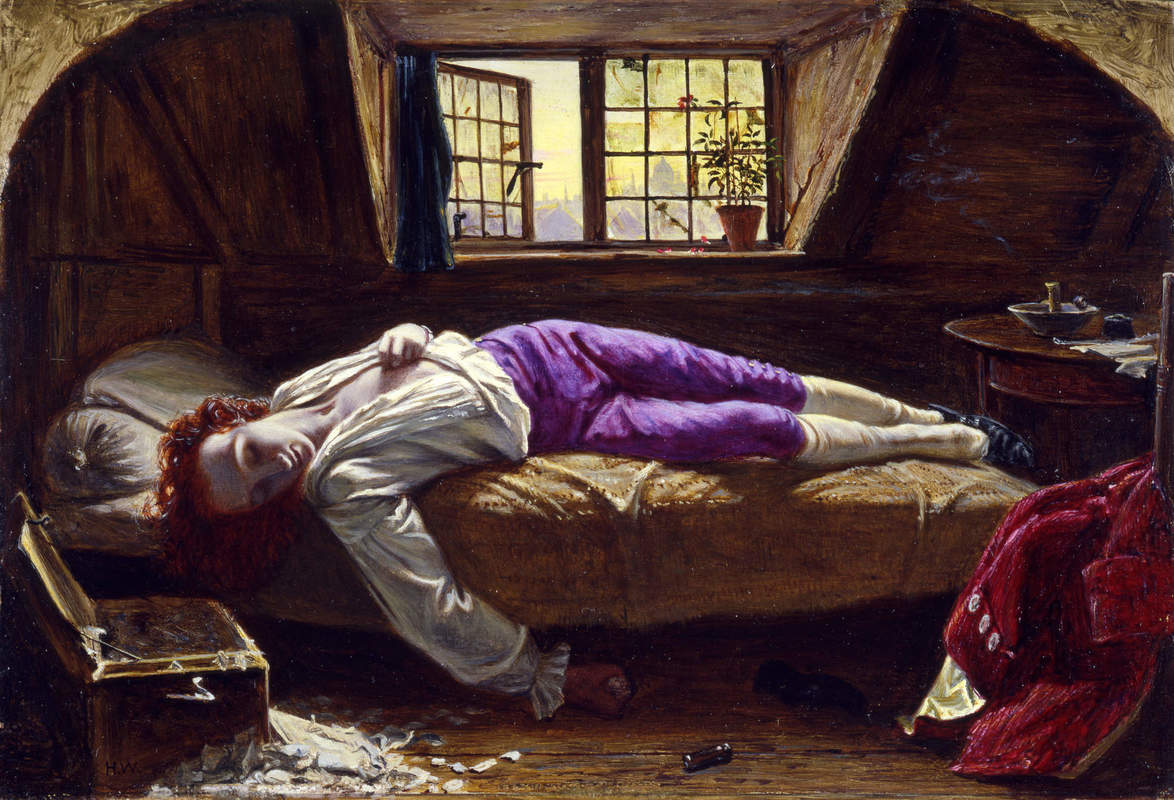
Courtesy: By Henry Wallis – Birmingham Museum and Art Gallery, Public Domain, https://commons.wikimedia.org/w/index.php?curid=4254164
Wallis’ famous painting depicts the death of the 18th Century Romantic poet Thomas Chatterton. He had poisoned himself with arsenic. While the events in “Lord Randall” are different, the tragic similarities between the poem by Anonymous and the power of Wallis’ painting emerge from the poem and the art image.
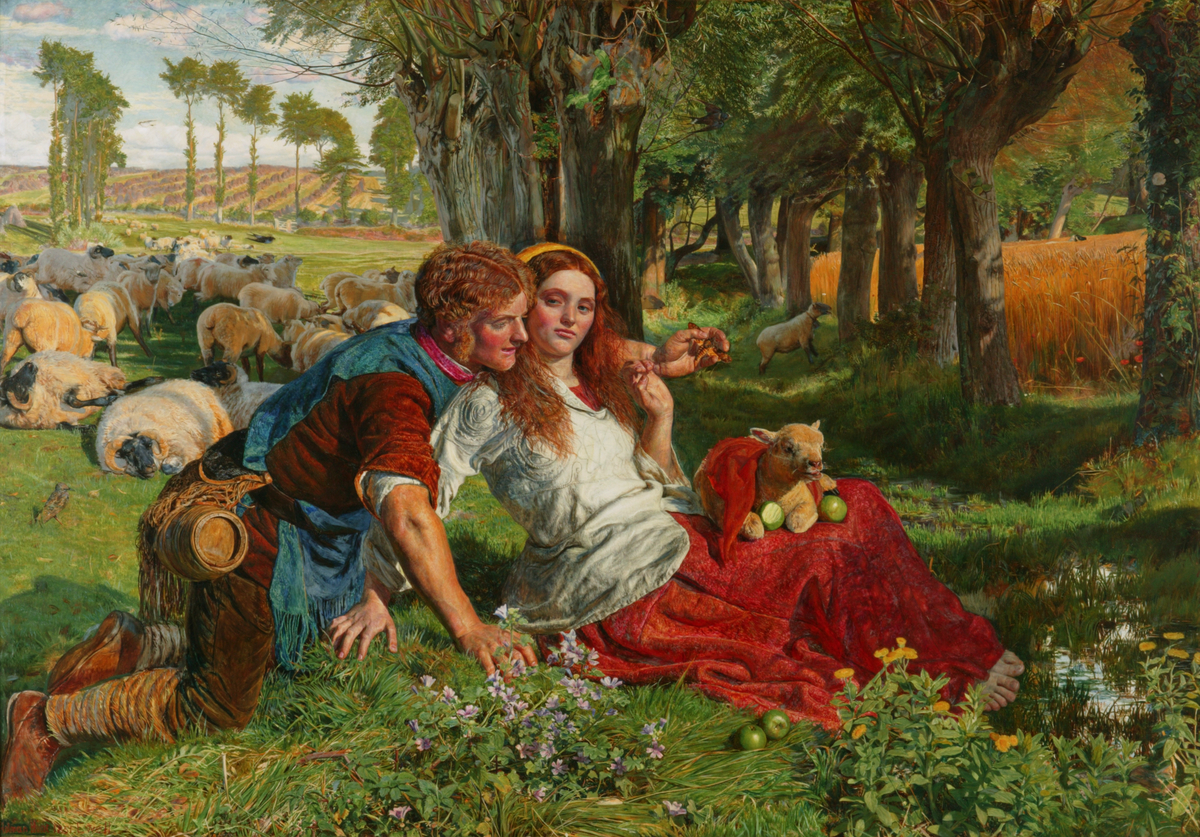
Courtesy: By William Holman Hunt – The Yorck Project (2002) 10.000 Meisterwerke der Malerei (DVD-ROM), distributed by DIRECTMEDIA Publishing GmbH. ISBN: 3936122202., Public Domain, https://commons.wikimedia.org/w/index.php?curid=153062
“The Passionate Shepherd to His Love” by Christopher Marlowe
Come live with me and be my love,
And we will all the pleasures prove,
That Valleys, groves, hills, and fields,
Woods, or steepy mountain yields.
And we will sit upon the Rocks,
Seeing the Shepherds feed their flocks,
By shallow Rivers to whose falls
Melodious birds sing Madrigals.
And I will make thee beds of Roses
And a thousand fragrant posies,
A cap of flowers, and a kirtle
Embroidered all with leaves of Myrtle;
A gown made of the finest wool
Which from our pretty Lambs we pull;
Fair lined slippers for the cold,
With buckles of the purest gold;
A belt of straw and Ivy buds,
With Coral clasps and Amber studs:
And if these pleasures may thee move,
Come live with me, and be my love.
The Shepherds’ Swains shall dance and sing
For thy delight each May-morning:
If these delights thy mind may move,
Then live with me, and be my love.
To listen to the musical rendition of Marlowe’s famous poem, please open the link here.
“The Blessed Damozel” by Dante Gabriel Rossetti (1828-1882)
The blessed Damozel leaned out
From the gold bar of Heaven:
Her blue-grey eyes were deeper much
Than a deep water, even.
She had three lilies in her hand,
And the stars in her hair were seven.
II.
Her robe, ungirt from clasp to hem,
No wrought flowers did adorn,
But a white rose of Mary’s gift
On the neck meetly worn;
And her hair, lying down her back,
Was yellow like ripe corn.
III.
Her seemed she scarce had been a day
One of God’s choristers;
The wonder was not yet quite gone
From that still look of hers;
Albeit to them she left, her day
Had counted as ten years.
IV
To one it is ten years of years
Yet now, here in this place,
Surely she leaned o’er me,—her hair
Fell all about my face . . .
Nothing: the Autumn-fall of leaves.
The whole year sets apace…..
“The Blessed Damozel” by Dante Gabriel Rosetti (1850)
This dramatic lyric poems composed of 24 stanza (6 lines each) was written in 1850 by Rossetti. Rosetti had been influenced by E.A. Poe’s “The Raven.” In Rossetti’s poem, the woman looks down from heaven on her lover. It is a poem about the bond of love; death cannot separate the spiritual connection of the lovers and at some point, they will be reunited. Like William Blake, Dante Gabriel Rossetti was also a literary artist. His paintings often mirrored the poems he wrote.
The complete poem can be found when you open the Project Gutenberg link below.
https://www.gutenberg.org/cache/epub/52695/pg52695-images.html
Information about the Poem:

Courtesy: By Dante Gabriel Rossetti – http://www.wikiart.org/en/dante-gabriel-rossetti/the-blessed-damozel-1878, Public Domain, https://commons.wikimedia.org/w/index.php?curid=11235787
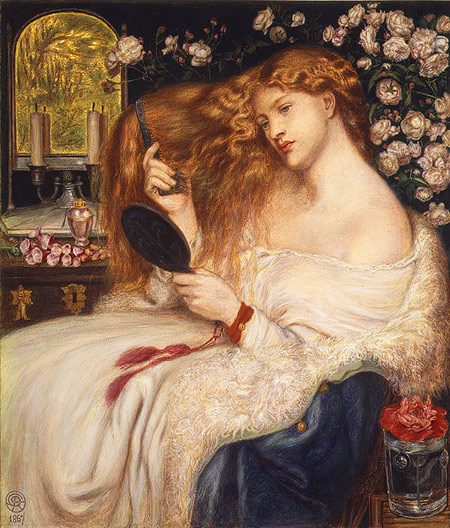
Courtesy: By Dante Gabriel Rossetti – “Dante Gabriel Rossetti: Lady Lilith (08.162.1)”. In Heilbrunn Timeline of Art History. New York: The Metropolitan Museum of Art, 2000–. https://www.metmuseum.org/toah/works-of-art/08.162.1 (October 2006), Public Domain, https://commons.wikimedia.org/w/index.php?curid=11242810
Metropolitan Museum of Art Note about Rossetti’s Painting of Lilith
“Reflecting the “cult of beauty” that arose during the late 19th century, Rossetti here imagines a legendary femme fatale as a self-absorbed nineteenth-century beauty who combs her hair and seductively exposes her shoulders. Nearby flowers symbolize different kinds of love. In Jewish literature, the enchantress Lilith is described as Adam’s first wife, and her character is underscored by lines from Goethe’s Faust attached by Rossetti to the original frame, “Beware . . . for she excels all women in the magic of her locks, and when she twines them round a young man’s neck, she will not ever set him free again.” The artist’s mistress, Fanny Cornforth, is the sitter in this watercolor, which Rossetti and his assistant Dunn based on an oil of 1866 (Delaware Art Museum).”
“Sonnet LXXVIII: Body’s Beauty” by Dante Gabriel Rossetti
Of Adam’s first wife, Lilith, it is told
[The witch he loved before the gift of Eve]
That, ere the snake’s, her sweet tongue could deceive,
And her enchanted har was the first gold.
And still she sits, young while the earth is old,
And, subtly of herself contemplative,
Draws men to watch the bright web she can weave,
Till heart and body and life are in its hold.
The rose and poppy are her flowers; for where
Is she not found, O Lilith, whom shed scent
And soft-shed kisses and soft sleep snare?
Lo! As that youth’s eyes burned at thine, so went
Thy spell through him, and left his straight neck bent
And round his heart one strangling golden hair
The Cult of Beauty and The Pre-Raphaelite Movement in Art
The Pre-Raphaelites were a group of Victorian painters, designers, illustrators and artists (1848-1900s) who drew inspiration from the richly coloured and detailed Renaissance paintings. Youth, beauty, romantic yearning, love, death, altered states of consciousness, and moral themes were reflected in their work. Pre-Raphaelite artists like Dante Gabriel Rossetti, Edward Burne-Jones, William Morris, George Frederick Watts, William Holman Hunt, John Everett Milais, Maria Spartali Stillman, Christina Rossetti, and Evelyne De Morgan drew inspiration from Celtic, medieval, and classical myths and legends literature and art. The Pre-Raphaelites aimed to “modernize” art by revitalizing medieval art and literature that recounted Arthurian legends and the chivalric code. Their imaginative and narrative paintings were viewed as a reaction and revolt to the increasing mechanization and industrialization of the late Victorian period. Bright colours, sharp contours, and close attention to details of beauty, nature, and landscape. Collectively these artists influenced the Symbolist Movements in Art and the Arts and Crafts design movement in the first half of the 20th century. The idealized versions of youth, beauty, and womanhood evolved into a “cult of beauty” that influenced aesthetics, fashion, and design.
To read an essay about the Pre-Raphaelite artists, please open the link here, here, and here.
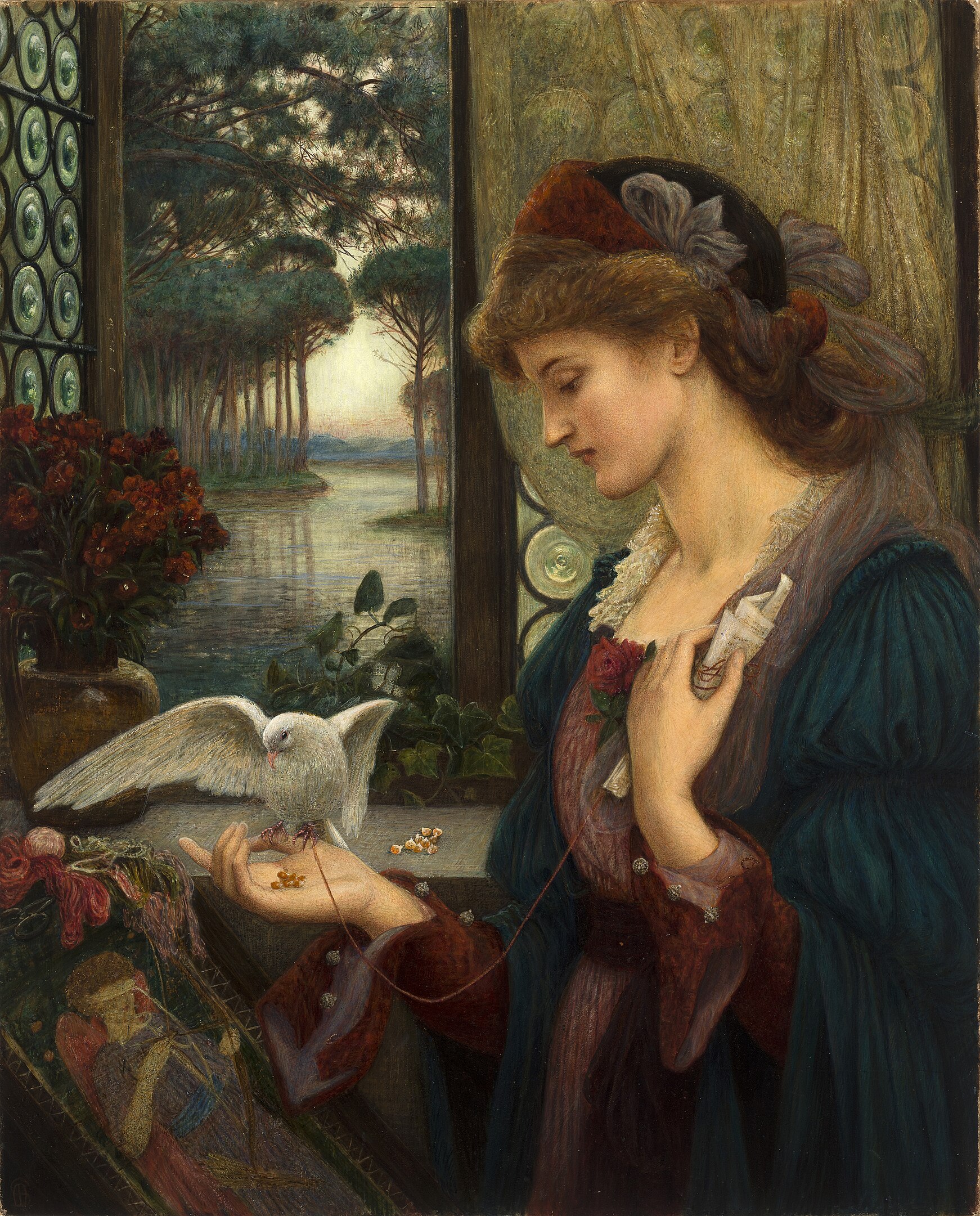
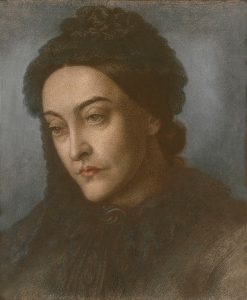
That she should ever grow so calm as this,
With self-remembrance in her warmest kiss
And dim dried eyes like an exhausted well.
Slow-speaking when she has some fact to tell,
Silent with long-unbroken silences,
Centred in self yet not unpleased to please,
Gravely monotonous like a passing bell.
Mindful of drudging daily common things,
Patient at pastime, patient at her work,
Wearied perhaps but strenuous certainly.
Sometimes I fancy we may one day see
Her head shoot forth seven stars from where they lurk
And her eyes lightnings and her shoulders wings.
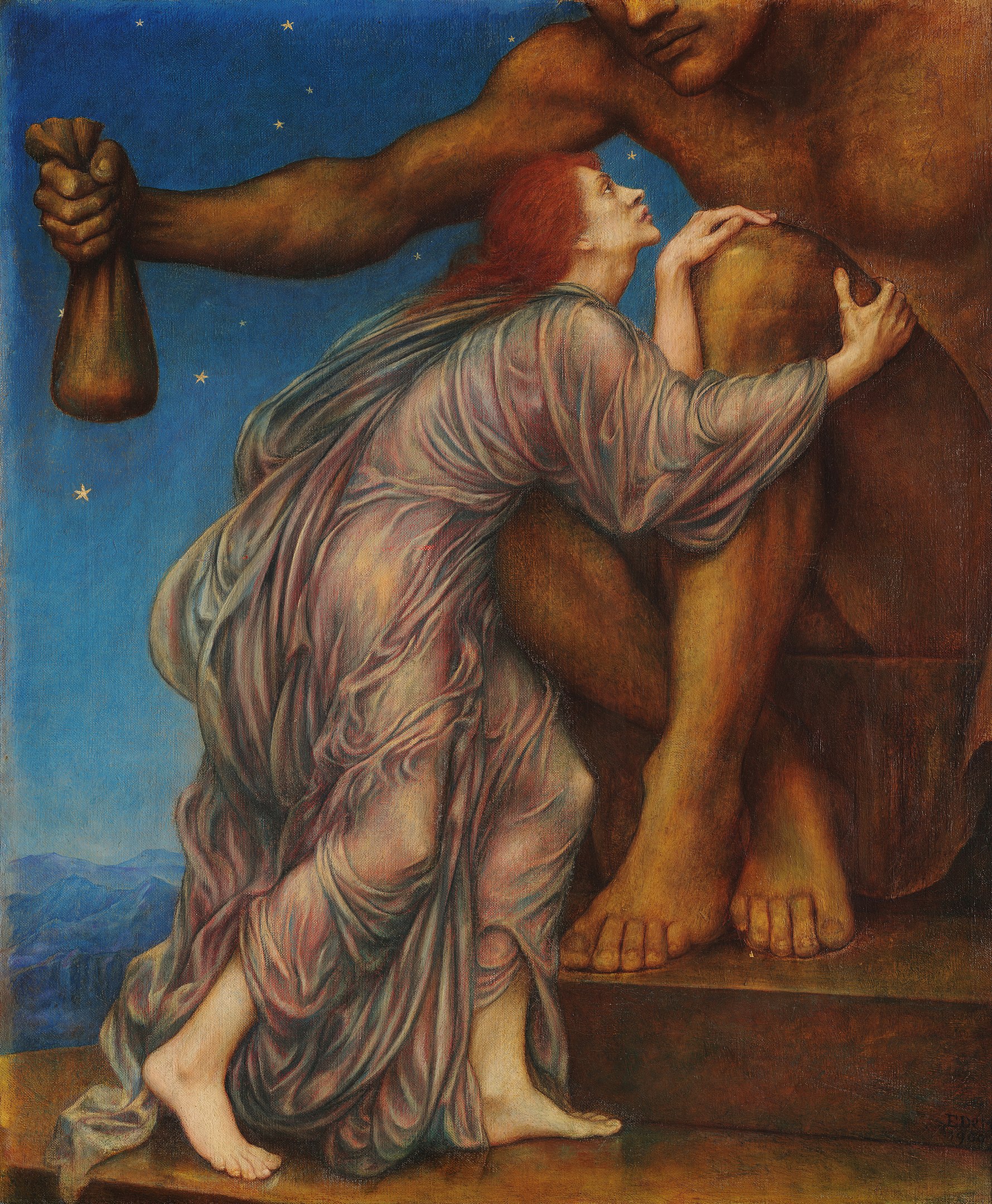
Courtesy: By Evelyn De Morgan – [1], Public Domain, https://commons.wikimedia.org/w/index.php?curid=1147026
Resources
For more information about The Pre-Raphaelite artists like Dante Gabriel Rossetti, please consult the essay here.
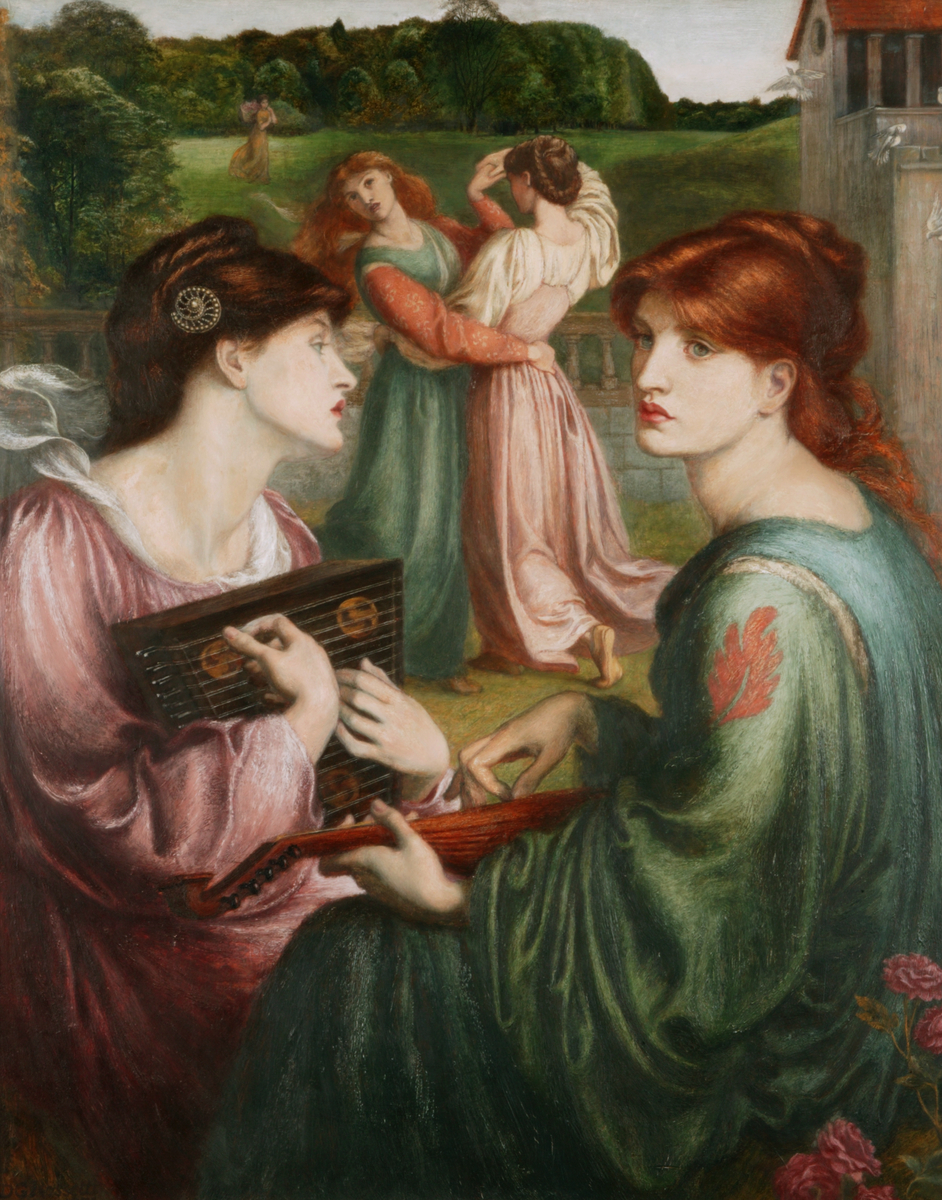
Courtesy: By Dante Gabriel Rossetti – Art Renewal Center, Public Domain, https://commons.wikimedia.org/w/index.php?curid=74024
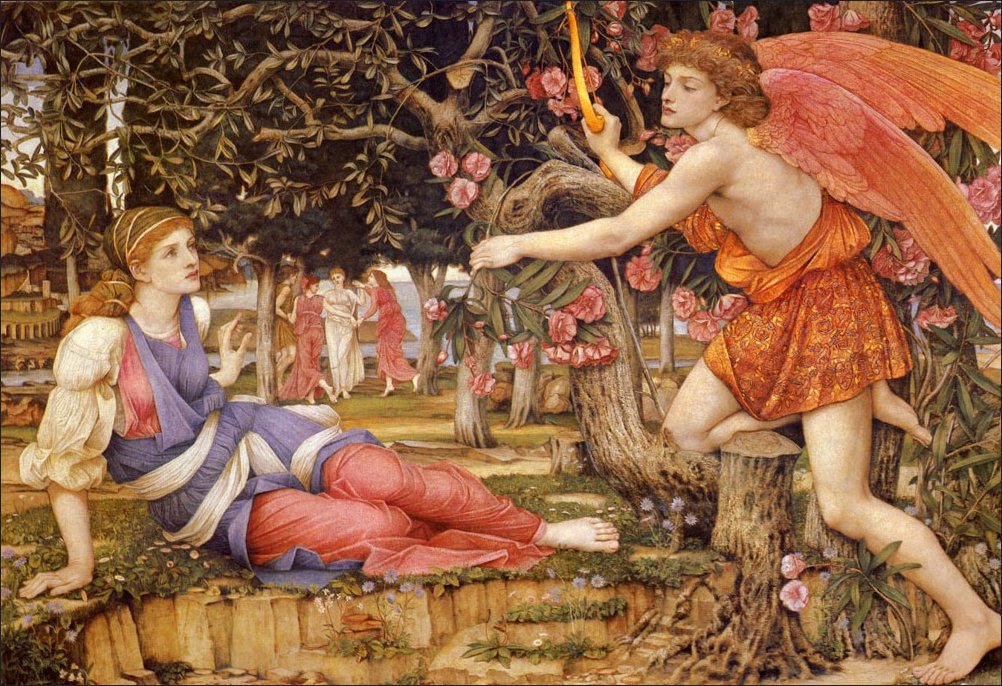
Courtesy: By John Roddam Spencer Stanhope – Fine Arts Museums of San Francisco, Public Domain, https://commons.wikimedia.org/w/index.php?curid=7804272
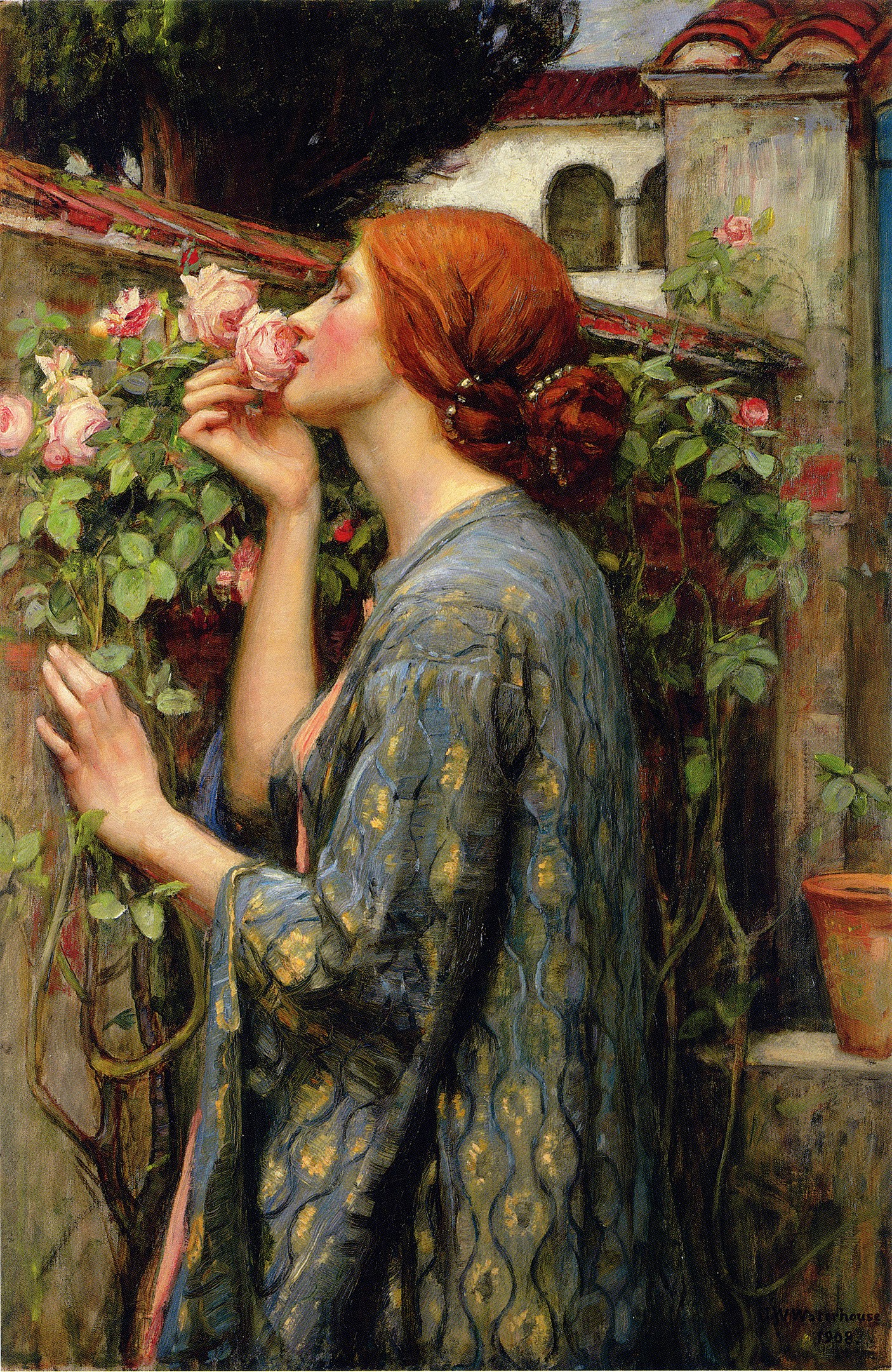
Courtesy: By John William Waterhouse – Art Renewal Center, Public Domain, https://commons.wikimedia.org/w/index.php?curid=39913901
“A Dead Rose”by Elizabeth Barrett Browning
O Rose! who dares to name thee?
No longer roseate now, nor soft, nor sweet;
But pale, and hard, and dry, as stubble-wheat,—-
Kept seven years in a drawer—-thy titles shame thee.
The breeze that used to blow thee
Between the hedgerow thorns, and take away
An odour up the lane to last all day,—-
If breathing now,—-unsweetened would forego thee.
The sun that used to smite thee,
And mix his glory in thy gorgeous urn,
Till beam appeared to bloom, and flower to burn,—-
If shining now,—-with not a hue would light thee.
The dew that used to wet thee,
And, white first, grow incarnadined, because
It lay upon thee where the crimson was,—-
If dropping now,—-would darken where it met thee.
The fly that lit upon thee,
To stretch the tendrils of its tiny feet,
Along thy leaf’s pure edges, after heat,—-
If lighting now,—-would coldly overrun thee.
The bee that once did suck thee,
And build thy perfumed ambers up his hive,
And swoon in thee for joy, till scarce alive,—-
If passing now,—-would blindly overlook thee.
The heart doth recognise thee,
Alone, alone! The heart doth smell thee sweet,
Doth view thee fair, doth judge thee most complete,—-
Though seeing now those changes that disguise thee.
Yes, and the heart doth owe thee
More love, dead rose! than to such roses bold
As Julia wears at dances, smiling cold!—-
Lie still upon this heart—-which breaks below thee.
“How do I love thee? Let me count the ways. (Sonnet 43)” by Elizabeth Barrett Browning
I love thee to the depth and breadth and height
My soul can reach, when feeling out of sight
For the ends of being and ideal grace.
I love thee to the level of every day’s
Most quiet need, by sun and candle-light.
I love thee freely, as men strive for right.
I love thee purely, as they turn from praise.
I love thee with the passion put to use
In my old griefs, and with my childhood’s faith.
I love thee with a love I seemed to lose
With my lost saints. I love thee with the breath,
Smiles, tears, of all my life; and, if God choose,
I shall but love thee better after death.
To read more from Sonnets of the Portugese by Elizabeth Barrett Browning, please open the link here.
For more information about Elizabeth Barrett Browning’s poems, please open this link: The Poems of Elizabeth Barrett Browning.
Questions for Further Reflection
Which love poems and images in this section did you find most compelling?
Is there “love at first sight”?
How would you define love? What “ingredients” are necessary?
What are the differences between love and infatuation?
How does our society portray “love” in movies, advertisements, and in the wider culture? What messages are sent early on about the necessity for individuals to find a life partner?
Comment on the popularity of online dating. What are the promises and the pitfalls?
How would you characterize different “faces” of love: platonic, romantic, sibling and parental love, love for country and community, etc.

